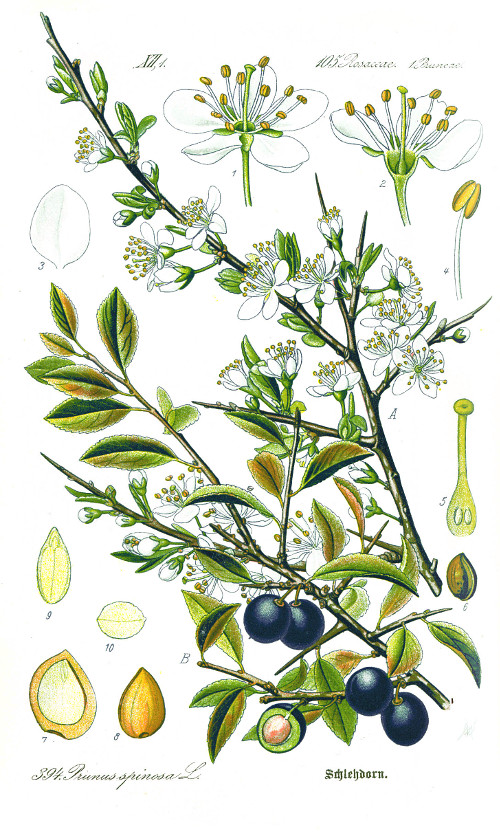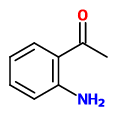Prunus spinosa L. - Rosaceae - blackthorn, sloe, sloeberry, Schlehe, Schwarzdorn
Deciduous shrub, up to 3m high, native to Europe, West Asia, North Africa; branches reddish brown, spiny; leaves 2-5cm long, ovate to oblong, crenate, abaxially yellowish green and pubescent, adaxially dark green and sparsely appressed pubescent; flowers fragrant, white, solitary, appearing before the leaves, petals 6mm long; fruits globose, deep blue to nearly black, glaucous.
„This species is cultivated for its edible fruit and as grafting stock for other species of Prunoideae.“
http://www.efloras.org/florataxon.aspx?flora_id=2&taxon_id=200011162
„The combination of 2-aminobenzaldehyde and 2-aminoacetophenone, sometimes accompanied by methyl anthranilate, can be regarded as a scent concept important to nature and frequently found in nature, e.g. In Prunus species.“ The headspace of Prunus spinosa flower contained 2-aminobenzaldehyde (0.4%; orange-flower like) and 2-aminoacetophenone (0.1%; grape, sweet green; high impact - odor threshold in the picogram range). [R.Kaiser, Scent of the Vanishing Flora, Zurich 2011, 21, 34]
The ripe fruits are usually harvested after the first frost on the bush. By natural or artificial freezing, a big part of the astringent tannins of the fruit is enzymatically degraded. In this case, the tannin content of the juice decreases from about 1% to less than 0.5%. Complete degradation of tannins is not intended because of their significant contribute to flavor.
http://de.wikipedia.org/wiki/Schlehdorn
Benzaldehyde, benzyl alcohol, 1-hexanol and (E)-2-hexenal were selected by AEDA as principal aroma-active components of P.spinosa fruits.
[Dolezal, M., Velíšek, J., Famfulíková, P., Pfannhauser, W., Fenwick, G. R., & Khokhar, S. (2001). Chemical composition of less-known wild fruits. In Biologically-active phytochemicals in food: analysis, metabolism, bioavailability and function. Proceedings of the EUROFOODCHEM XI Meeting, Norwich, UK, 26-28 September 2001. (pp. 241-244). Royal Society of Chemistry.]
„The dried fruits (or fruit juice) are used to treat inflammation of the mouth, gums and throat. Numerous medicinal properties have been ascribed to the flowers (expectorant, mild laxative, diuretic and diaphoretic)… Mainly present are tannins, flavanoids and cyanogenic glycosides… Tannins are known for their antiseptic, anti-diarrhoeal and anti-inflammatory effects.“
[Medicinal Plants of the World. Ben-Erik Van Wyk and Michael Wink, Pretoria 2004, 257]
„In the 5-lipoxygenase test the fresh fruit juice of P.spinosa showed a good antioxidant activity when compared to trolox; in the DPPH test the samples showed IC50 values that were comparable to ascorbic acid, while the ORAC value was 36.02 μmol eq. trolox/g of fruit. These values are in accord with data reported in the literature for small fruits such as vaccinium, rubus and ribes. the antioxidant activity of red berries is correlated with the anthocyanin content. the results of this study indicate that the three most
representative anthocyanins in sloe fruit juice (cyanidin-3-rutinoside, peonidin-3-rutinoside and cyanidin-3-glucoside) contribute in varying amounts to the antioxidant properties.“
[Antioxidant activity of Prunus spinosa L. fruit juice., Fraternale, D., Giamperi, L., Bucchini, A., Ricci, D., Ital J Food Sci, Vol.21, 2009, 337-346]
http://www.chiriotti.it/pdf/ijfs/IJFS213.pdf#page=86
„P.spinosa fruits are… commonly prepared in jams or macerated with sugar, honey and brandy to obtain a digestive and laxative liqueur… P.spinosa fruits presented the highest concentration in phenolic acids (29.78 mg/100 g dw), being 3-O-caffeoylquinic acid the most abundant one, and flavone/ols (57.48 mg/100 g), among which quercetin-3-O-rutinoside (15.63 mg/100g) was the major compound.“
[Guimarães, R., Barros, L., Dueñas, M., Carvalho, A. M., Queiroz, M. J. R., Santos-Buelga, C., & Ferreira, I. C. (2013). Phenolic profile of Arbutus unedo L. and Prunus spinosa L. wild fruits.]

Thomé, O.W., Flora von Deutschland Österreich und der Schweiz, Tafeln, vol.3, t.394 (1885)
http://plantgenera.org/species.php?id_species=1266519
Prunus spinosa © Rolf Marschner (2007) www.botanische-spaziergaenge.at


